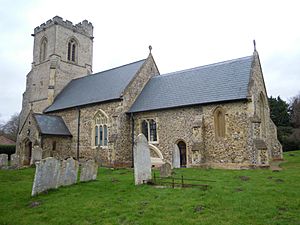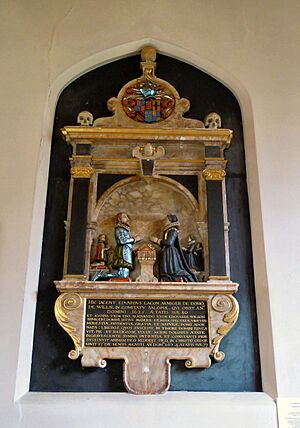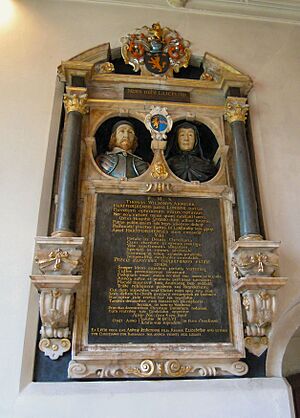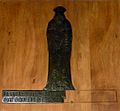Church of All Saints, Willian facts for kids
The Church of All Saints is a special church in the village of Willian in Hertfordshire, England. It's an Anglican church, which means it belongs to the Church of England.
This church works closely with St Paul's church in nearby Letchworth. Even though they work together, each church has its own local area called a parish.
The Church of All Saints is part of the Diocese of St Albans, which is like a larger church district. It has been a very important building since 1954, recognized as a Grade II* listed building. This means it's a historic place that needs to be protected.
Contents
Looking at the Outside of the Church
The Church of All Saints is very old, going back to at least the Norman times. It has a main hall called a nave and a special area near the altar called a chancel. The nave was built in the 12th century, and the chancel in the 13th century.
The church tower and the south porch were added in the 15th century. The tower has three levels and a staircase inside. It also has a battlemented top, which looks like the top of a castle wall.
Meet the Gargoyles
You'll see eight gargoyles on the tower. These are carved stone figures, often shaped like monsters, that help drain rainwater away from the building. Seven of these gargoyles were replaced in 1996. New ones were carved to show opposites, like Life and Death, or a King and a Queen.
The clock on the tower was put there in 1897 to celebrate Queen Victoria's Diamond Jubilee. It was fixed up in 1991. The strong supports on the outside walls, called buttresses, were added in the 15th and 19th centuries to help hold up the church.
The roof is made of Welsh slate. The church walls are built from flint and ironstone, with smooth stone blocks called ashlar around the edges. The windows, added in the 14th and 15th centuries, are in a style called Perpendicular.
Exploring Inside the Church
Inside the church, both the nave and chancel have a curved wooden ceiling, like the inside of a barrel. This roof was built in the 19th century. The chancel still has its original carved faces, called corbel masks, and old seats.
The nave feels tall and bright because of changes made between 1866 and 1870. During this time, a new window was added, and the roof was made higher. Two windows facing each other date back to about 1430, but the colorful stained glass in them was put in much later, in 1918. The main walls of the church are very old, from around 1100 to 1150.
Special Carvings and Furniture
The communion table stands out in the church. Behind it, on the president's chair, there's a carving of an elephant and a castle. This chair was made in 1974 using old wooden pieces from the Middle Ages. On a side panel, you can see a carving of John the Baptist's head on a plate. Experts think these carvings were first made around 1475 for St Andrew's church in Biggleswade and brought to Willian around 1830.
You can also see a special brass plaque for Richard Golden, a priest who died in 1446. The walls have many beautiful monuments. In the chancel, there are monuments for Edward and Joan Lacon (who died in 1625 and 1624), John Chapman (died 1624), and Thomas Wilson (died 1656). Thomas Wilson's monument is a rare and beautiful example. These monuments were cleaned and repainted in 1974.
The church has two lecterns, which are stands for reading. The newer one was given in memory of Samuel Valentine, who passed away in 1974. The older one was given in 1870 by Thomas Legh Claughton, who was the Bishop of Rochester at that time. The original screen that separated the nave from the chancel, called a rood screen, was removed.
Above the arch leading to the tower, you can see the Royal Arms, which were likely placed there during the church's restoration in 1870. At the bottom of the tower, there's a special device called the Ellacombe chiming apparatus. This allows one person to ring all six bells. The oldest bell still in its original state is from 1662. The organ was built in 1864 and fixed up in 1986. The Victorian baptismal font is thought to be the fourth one the church has had. The one before it was used as a plant pot!
People Buried Here
The churchyard is a resting place for several notable people. One is Annie Jane Lawrence, who built a famous building called The Cloisters in nearby Letchworth.
Also buried here is Bernard George Ellis GC. He was awarded the Albert Medal in 1919 for saving lives. This medal was later changed to the George Cross in 1970.
The churchyard also has five graves looked after by the Commonwealth War Graves Commission. One grave is from World War I, and four are from World War II.
Gallery







